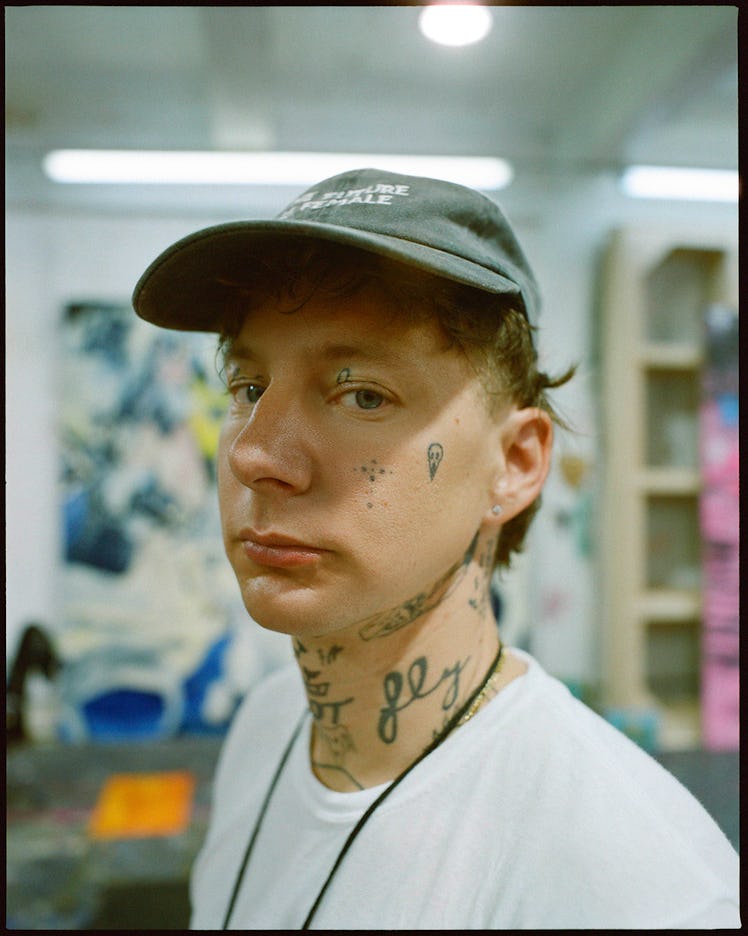Florian Krewer Paints the World as He Feels It
The German-born artist discusses confronting greed, fear, and fading freedom in his latest works.

You have become known for paintings of men out and about that are wildly colored and psychologically charged. You have a solo exhibition this fall, at the Michael Werner Gallery in New York. What feels new about this work?
One painting is about a drag queen, and she’s on the floor [Stage for Life, 2025]. When you go to drag shows, normally they’re packed, and now they feel empty. It feels like New York’s vibe is getting more conservative in certain areas. I have this kind of new feeling that I tried to bring into the painting.
Animals have appeared in your work for a long time—they’re an enigmatic presence. In one painting, there are large birds surrounding a masked child.
For me, this is a political painting. Now all the CEOs are getting into politics. There’s so much greed, and these are vultures. Also, there’s a lack of empathy. The young figure is fragile. It’s like the future—it feels disconnected from the older generations. Some people want to go back in time, stop abortion, and make sure transgender people don’t get passports. It’s horrible.
You’ve had a very unusual path to contemporary art—starting as a housepainter, then enrolling in architecture school in Cologne, Germany, where the architect Nikolaus Bienefeld encouraged your artwork.
He showed me how to mix the oil. I painted daily after school in a really small cellar. My mom would come down and say, “You’re fucking up the whole cellar!”
You then landed at the Kunstakademie Düsseldorf and studied with Peter Doig, before coming to New York around five years ago. Do you ever want to go back to Germany?
I don’t, to be honest. It’s too closed-minded. Here, you can be a little bit more yourself, and open.
What is intriguing about your work is that it tends to depict things that don’t often end up in paintings, and that are absent in art history, like young men being led away in handcuffs. How did that come about?
I had a stalker for three years.
Holy shit.
That was creepy. They came with a knife and tried to break into my apartment. I went to the police to report it. And there I saw so many young people who got locked up. That’s a horrible kind of fear. If it’s a serious crime, sure, but often it’s a small thing. This is how it operates here, the prison system. It’s private; they make money out of it.
You turn 40 next year, but you still seem attuned to what young people are doing and thinking about—painting someone surfing atop a subway car, for instance. Some have died doing that.
I was with a friend here in the Bronx, where I have my studio, and we saw a couple of them on the train, surfing. It shows how the young generation is so on edge. You have social media, so that’s like the big stage. If you post a video like that, it will definitely go viral. When I was a kid growing up in Germany, we jumped from garages. I was flying once and landed like Superman and broke my arm.
A couple years ago, you were making paintings that were basically pornographic. Are you currently doing anything like that?
No. I was trying things out. I went once with a friend to a gay sauna in Germany—whatever you can imagine going on in there. That was interesting, but it’s not me as a person, really. I enjoyed it for that moment and thought I wanted to show it.
Looking at those pictures, I was wondering: How is he going to top this?
That’s the thing. I don’t do what people want—to think, like, Now he needs to go harder. No, I don’t need to.
Is there anything that you want people to know coming into your show, or that you want to get on the record?
More love in the world.